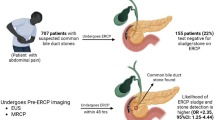Abstract
Background and Aims
Magnetic resonance cholangiography (MRC), endoscopic ultrasound (EUS), and endoscopic retrograde cholangio-pancreatography (ERCP) all represent viable options to establish the diagnosis of choledocholithiasis. The aim of the study was to assess how the three imaging modalities perform in head-to-head comparisons and in what order to apply them when using these procedures sequentially.
Methods
A threshold analysis using a decision tree was modeled to compare the costs associated with different imaging techniques of the biliary system in a patient with suspected cholestasis secondary to choledocholithiasis. The main outcome parameter was the pre-test probability of common bile duct (CBD) stones that would guide the physician towards starting the work-up with MRC or EUS versus going straight to ERCP as the primary procedure.
Results
For low pre-test probabilities of CBD stones in the common bile duct, MRC represents the procedure of choice. For pre-test probabilities ranging between 40 and 91 %, EUS should be the preferred imaging modality. If CBD stones are suspected with an even higher pre-test probability, patients could go straight to ERCP as their first procedure. Low costs associated with any of the three procedures increase its range of applicability at the expense of the other competing imaging modalities.
Conclusions
MRC, EUS, and ERCP should be used in sequence and dependent on the pre-test probability of choledocholithiasis.




Similar content being viewed by others
References
Ainsworth AP, Rafaelsen SR, Wamberg PA, Pless T, Durup J, Mortensen MB. Cost-effectiveness of endoscopic ultrasonography, magnetic resonance cholangiopancreatography and endoscopic retrograde cholangiopancreatography in patients suspected of pancreaticobiliary disease. Scand J Gastroenterol. 2004;39:579–583.
Tse F, Barkun JS, Romagnuolo J, Friedman G, Bornstein JD, Barkun AN. Nonoperative imaging techniques in suspected biliary tract obstruction. HPB (Oxford). 2006;8:409–425.
Tse F, Liu L, Barkun AN, Armstrong D, Moayyedi P. EUS: a meta-analysis of test performance in suspected choledocholithiasis. Gastrointest Endosc. 2008;67:235–244.
Kaltenthaler E, Vergel YB, Chilcott J, et al. A systematic review and economic evaluation of magnetic resonance cholangiopancreatography compared with diagnostic endoscopic retrograde cholangiopancreatography. Health Technol Assess. 2004;8:1–89.
ASGE Standards of Practice Committee, Maple JT, Ben-Menachem T, et al. The role of endoscopy in the management of choledocholithiasis. Gastrointest Endosc. 2010;71:1–9.
Pauker SG, Kassirer JP. The threshold approach to clinical decision making. N Engl J Med. 1980;302:1109–1117.
Sonnenberg A. Decision analysis in clinical gastroenterology. Am J Gastroenterol. 2004;99:163–169. Erratum in: 2004;99:398.
Sonnenberg A, Rodriguez SA, Faigel DO. Diagnostic ascertainment of suspicious pancreatic mass: a threshold analysis. Clin Gastroenterol Hepatol. 2008;6:1162–1166.
Scheiman JM, Carlos RC, Barnett JL, et al. Can endoscopic ultrasound or magnetic resonance cholangiopancreatography replace ERCP in patients with suspected biliary disease? A prospective trial and cost analysis. Am J Gastroenterol. 2001;96:2900–2904.
Carlos RC, Scheiman JM, Hussain HK, Song JH, Francis IR, Fendrick AM. Making cost-effectiveness analyses clinically relevant: the effect of provider expertise and biliary disease prevalence on the economic comparison of alternative diagnostic strategies. Acad Radiol. 2003;10:620–630.
Urbach DR, Khajanchee YS, Jobe BA, Standage BA, Hansen PD, Swanstrom LL. Cost-effective management of common bile duct stones: a decision analysis of the use of endoscopic retrograde cholangiopancreatography (ERCP), intraoperative cholangiography, and laparoscopic bile duct exploration. Surg Endosc. 2001;15:4–13.
Kharbutli B, Velanovich V. Management of preoperatively suspected choledocholithiasis: a decision analysis. J Gastrointest Surg. 2008;12:1973–1980.
Brown LM, Rogers SJ, Cello JP, Brasel KJ, Inadomi JM. Cost-effective treatment of patients with symptomatic cholelithiasis and possible common bile duct stones. J Am Coll Surg. 2011;212:1049–1060.
Epelboym I, Winner M, Allendorf JD. MRCP is not a cost-effective strategy in the management of silent common bile duct stones. J Gastrointest Surg. 2013;17:863–871.
Author contributions
Conception and design: A. Sonnenberg, B. K. Enestvedt, G. Bakis; decision analysis: A. Sonnenberg, G. Bakis; writing of manuscript: A. Sonnenberg, B. K. Enestvedt, G. Bakis.
Author information
Authors and Affiliations
Corresponding author
Ethics declarations
Conflict of interests
No financial support was received for this study. The authors have no personal interests to declare.
Rights and permissions
About this article
Cite this article
Sonnenberg, A., Enestvedt, B.K. & Bakis, G. Management of Suspected Choledocholithiasis: A Decision Analysis for Choosing the Optimal Imaging Modality. Dig Dis Sci 61, 603–609 (2016). https://doi.org/10.1007/s10620-015-3882-7
Received:
Accepted:
Published:
Issue Date:
DOI: https://doi.org/10.1007/s10620-015-3882-7




